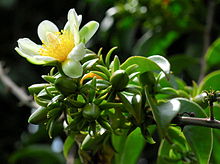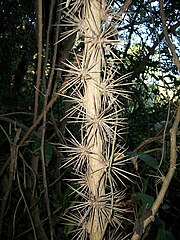Pereskia aculeata
| Pereskia aculeata | |
|---|---|

| |
| Scientific classification | |
| Kingdom: | Plantae |
| Clade: | Tracheophytes |
| Clade: | Angiosperms |
| Clade: | Eudicots |
| Order: | Caryophyllales |
| Family: | Cactaceae |
| Genus: | Pereskia |
| Species: | P. aculeata
|
| Binomial name | |
| Pereskia aculeata | |
| Synonyms[2] | |
| |
Pereskia aculeata is a scrambling shrub in the family
Description
Like other members of the genus .
It is a scrambling vine growing to 10 m (33 ft) tall in trees, with stems 2–3 cm (0.79–1.18 in) thick. Younger stems have hooked thorns and older stems have clusters of woody spines. The leaves are 4–11 cm (1.6–4.3 in) long and 1.5–4 cm (0.59–1.57 in) broad, simple, entire, and deciduous in the dry season. The strongly scented flowers are white, cream or pinkish, 2.5–5 cm (0.98–1.97 in) diameter, and numerous, produced in panicles. The fruit is a rounded berry, translucent white to light yellow, orange, or red, and 1.5–2 cm (0.59–0.79 in) in diameter. The leaves are edible, containing 20 to 30% of protein in the dry leaf matter. The fruits are also edible, containing numerous small seeds. It somewhat resembles the gooseberry in appearance and is of excellent flavor.[4]
Distribution
Native
South America, including French Guiana, Guyana, Suriname, Venezuela, Brazil, Colombia, Argentina and Paraguay.[5]
Introduced
Considered naturalized in the United States, Mexico, Central America, and the Caribbean. Also introduced to China, India, South Africa, Vietnam, Hawaii, Palau, French Polynesia, and Australia.[5]
Ecological significance
A flea-beetle (Phenrica guerini), a leaf-mining moth (Epipagis cambogialis), and a stem-wilter, (Catorhintha schaffneri), feed on the leaves.[5]
Although Pereskia aculeata is edible and of high nutrition quality, being an alternative to conventional food, this plant is a declared weed in South Africa where it does extensive damage to forest areas by smothering
Control
These plants are extremely difficult to kill and eradicate. It can be controlled by
Gallery
-
An old cut stem showing regrowth despite not being in contact with the ground
-
Growing in Ein Gedi Botanical Gardens
-
Mature stem at Ilanda Wilds
-
Centennial Park Conservatory, Toronto
References
- . Retrieved 17 December 2022.
- ^ "The Plant List: A Working List of All Plant Species". Retrieved 16 May 2014.
- ^ USDA GRIN Taxonomy, retrieved 3 May 2016
- ^ "Pereskia aculeata". www.llifle.com. Retrieved 14 March 2023.
- ^ ISSN 2958-3969.
- ^ Purves et al. (1995) [full citation needed]
- CABI ISC 19992302942.
External links
- Grocer's Encyclopedia: The Encyclopedia of Food and Beverage, by Artemas Ward, New York, 1911.
- http://www.hear.org/Pier/wra/pacific/pereskia_aculeata_htmlwra.htm
- Pooley, E. (1998). A Field Guide to Wild Flowers; KwaZulu-Natal and the Eastern Region. ISBN 0-620-21500-3.





